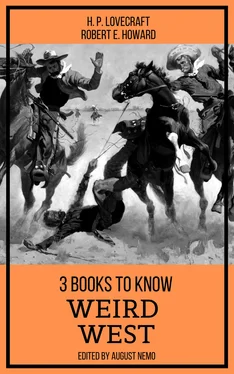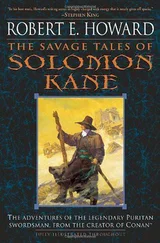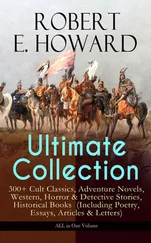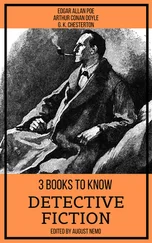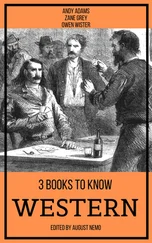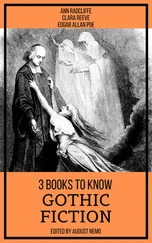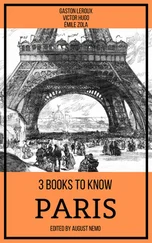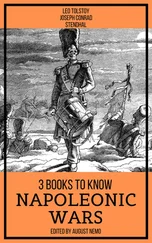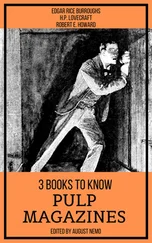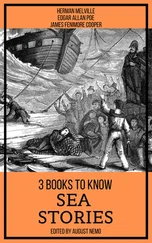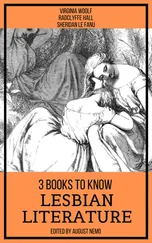It was only the waning light which checked me before I could unroll and read more, and in my impatient bafflement I almost forgot to be frightened at the onrush of night in this sinister place. Others, however, had not forgotten the lurking terror, for I heard a loud distant hallooing from a knot of men who had gathered at the edge of the town. Answering the anxious hail, I restored the manuscript to its strange cylinder—to which the disc around my neck still clung until I pried it off and packed it and my smaller implements for departure. Leaving the pick and shovel for the next day’s work, I took up my handbag, scrambled down the steep side of the mound, and in another quarter-hour was back in the village explaining and exhibiting my curious find. As darkness drew on, I glanced back at the mound I had so lately left, and saw with a shudder that the faint bluish torch of the nocturnal squaw-ghost had begun to glimmer.
It was hard work waiting to get at the bygone Spaniard’s narrative; but I knew I must have quiet and leisure for a good translation, so reluctantly saved the task for the later hours of night. Promising the townsfolk a clear account of my findings in the morning, and giving them an ample opportunity to examine the bizarre and provocative cylinder, I accompanied Clyde Compton home and ascended to my room for the translating process as soon as I possibly could. My host and his mother were intensely eager to hear the tale, but I thought they had better wait till I could thoroughly absorb the text myself and give them the gist concisely and unerringly.
Opening my handbag in the light of a single electric bulb, I again took out the cylinder and noted the instant magnetism which pulled the Indian talisman to its carven surface. The designs glimmered evilly on the richly lustrous and unknown metal, and I could not help shivering as I studied the abnormal and blasphemous forms that leered at me with such exquisite workmanship. I wish now that I had carefully photographed all these designs—though perhaps it is just as well that I did not. Of one thing I am really glad, and that is that I could not then identify the squatting octopus-headed thing which dominated most of the ornate cartouches, and which the manuscript called “Tulu”. Recently I have associated it, and the legends in the manuscript connected with it, with some new-found folklore of monstrous and unmentioned Cthulhu, a horror which seeped down from the stars while the young earth was still half-formed; and had I known of the connexion then, I could not have stayed in the same room with the thing. The secondary motif, a semi-anthropomorphic serpent, I did quite readily place as a prototype of the Yig, Quetzalcoatl, and Kukulcan conceptions. Before opening the cylinder I tested its magnetic powers on metals other than that of Grey Eagle’s disc, but found that no attraction existed. It was no common magnetism which pervaded this morbid fragment of unknown worlds and linked it to its kind.
At last I took out the manuscript and began translating—jotting down a synoptic outline in English as I went, and now and then regretting the absence of a Spanish dictionary when I came upon some especially obscure or archaic word or construction. There was a sense of ineffable strangeness in thus being thrown back nearly four centuries in the midst of my continuous quest—thrown back to a year when my own forbears were settled, homekeeping gentlemen of Somerset and Devon under Henry the Eighth, with never a thought of the adventure that was to take their blood to Virginia and the New World; yet when that new world possessed, even as now, the same brooding mystery of the mound which formed my present sphere and horizon. The sense of a throwback was all the stronger because I felt instinctively that the common problem of the Spaniard and myself was one of such abysmal timelessness—of such unholy and unearthly eternity—that the scant four hundred years between us bulked as nothing in comparison. It took no more than a single look at that monstrous and insidious cylinder to make me realise the dizzying gulfs that yawned between all men of the known earth and the primal mysteries it represented. Before that gulf Pánfilo de Zamacona and I stood side by side; just as Aristotle and I, or Cheops and I, might have stood.
––––––––

OF HIS YOUTH IN LUARCA, a small, placid port on the Bay of Biscay, Zamacona told little. He had been wild, and a younger son, and had come to New Spain in 1532, when only twenty years old. Sensitively imaginative, he had listened spellbound to the floating rumours of rich cities and unknown worlds to the north—and especially to the tale of the Franciscan friar Marcos de Niza, who came back from a trip in 1539 with glowing accounts of fabulous Cíbola and its great walled towns with terraced stone houses. Hearing of Coronado’s contemplated expedition in search of these wonders—and of the greater wonders whispered to lie beyond them in the land of buffaloes—young Zamacona managed to join the picked party of 300, and started north with the rest in 1540.
History knows the story of that expedition—how Cíbola was found to be merely the squalid Pueblo village of Zuñi, and how de Niza was sent back to Mexico in disgrace for his florid exaggerations; how Coronado first saw the Grand Canyon, and how at Cicuyé, on the Pecos, he heard from the Indian called El Turco of the rich and mysterious land of Quivira, far to the northeast, where gold, silver, and buffaloes abounded, and where there flowed a river two leagues wide. Zamacona told briefly of the winter camp at Tiguex on the Pecos, and of the northward start in April, when the native guide proved false and led the party astray amidst a land of prairie-dogs, salt pools, and roving, bison-hunting tribes.
When Coronado dismissed his larger force and made his final forty-two-day march with a very small and select detachment, Zamacona managed to be included in the advancing party. He spoke of the fertile country and of the great ravines with trees visible only from the edge of their steep banks; and of how all the men lived solely on buffalo-meat. And then came mention of the expedition’s farthest limit—of the presumable but disappointing land of Quivira with its villages of grass houses, its brooks and rivers, its good black soil, its plums, nuts, grapes, and mulberries, and its maize-growing and copper-using Indians. The execution of El Turco, the false native guide, was casually touched upon, and there was a mention of the cross which Coronado raised on the bank of a great river in the autumn of 1541—a cross bearing the inscription, “Thus far came the great general, Francisco Vásquez de Coronado”.
Конец ознакомительного фрагмента.
Текст предоставлен ООО «ЛитРес».
Прочитайте эту книгу целиком, купив полную легальную версию на ЛитРес.
Безопасно оплатить книгу можно банковской картой Visa, MasterCard, Maestro, со счета мобильного телефона, с платежного терминала, в салоне МТС или Связной, через PayPal, WebMoney, Яндекс.Деньги, QIWI Кошелек, бонусными картами или другим удобным Вам способом.
